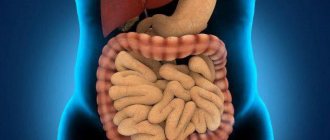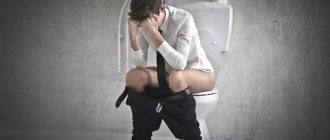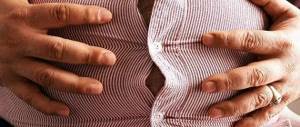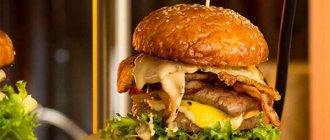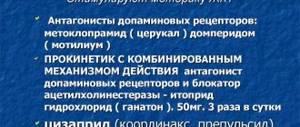Reasons for appearance
Diarrhea with bile occurs for a number of reasons.
- Dysbacteriosis. A disease caused by an imbalance between beneficial and pathogenic bacteria. Microorganisms necessary for the processing of bile are destroyed. The unprocessed substance irritates the intestinal walls - yellow diarrhea appears.
- Intoxication. The amount of bile in the stool increases sharply due to the abundance of pathogenic bacteria in the intestinal microflora. Pure bile enters the intestines, causing severe irritation and digestive dysfunction. In case of food poisoning, the feces become sharply yellow due to the abundance of bile.
- Alcohol addiction. Drinking strong alcoholic beverages disrupts the normal functioning of the gastrointestinal tract, and a person produces feces with bile.
- Excess fatty foods in the diet. Processing food with an abundance of fat increases intestinal motility and leads to dysfunction of the body's biliary system. Therefore, bile diarrhea occurs.
- Cholecystectomy. When the gallbladder is removed, disruption of the stool structure is considered normal. Since bile has nowhere else to accumulate, it constantly enters the intestines and then into the stool.
- Malabsorption syndrome. The villi of the small intestine do not absorb nutrients, and food is not completely digested. Because of this, bile, mucus and fat get into the stool.
- Dyskinesia. If the bile ducts are clogged, hologenic diarrhea occurs, alternating with delayed bowel movements. If dyskinesia is chronic, then bile stagnation occurs, stones form, and inflammation begins. This is accompanied by sharp pain and other unpleasant symptoms.
Preventive measures
Often, a regular diet helps cure diarrhea, which is caused by gallbladder diseases. In case of inflammation, it is recommended to adhere to a diet that corresponds to table No. 5.
Food should be consumed in small portions, 4–6 times a day. Dishes should not irritate the mucous membranes of the digestive organs, so hot and cold foods are prohibited.
You need to eat slowly, chewing food thoroughly.
Fatty, fried, salty, smoked, spicy and alcoholic drinks are excluded from the menu. You need to eat light meals from vegetables, cereals, lean meat and fish. They are boiled, steamed or baked in the oven.
Moderate physical activity has a beneficial effect on the functioning of the gallbladder and the entire gastrointestinal tract:
- walking in the fresh air;
- swimming in the pool;
- physiotherapy;
- maintaining an active lifestyle.
To prevent future diarrhea, it is recommended:
- Visit your doctor in a timely manner and monitor the condition of the gallbladder and other organs.
- Do not choose medications yourself.
- Get rid of bad habits.
- Avoid stress.
Cholelithiasis
is a disease accompanied by the formation of stones in the gall bladder (cholecystolithiasis) or in the bile ducts (choledocholithiasis). Stones are formed as a result of precipitation of bile pigments, cholesterol, certain types of proteins, calcium salts, infection of bile, its stagnation, and lipid metabolism disorders. The disease may be accompanied by pain in the right hypochondrium, biliary colic, and jaundice. Surgery is required. The pathology can be complicated by cholecystitis, fistula formation, and peritonitis.
Diagnostics
For pain in the iliac abdomen and yellow diarrhea, a comprehensive examination is necessary. If there is stool with bile in an adult, tests are prescribed.
- General blood analysis. If there are problems with the gallbladder, the concentration of hepatic ALT and AST increases. Alkaline phosphatase levels increase and bilirubin rises. There is a high level of “bad” cholesterol and diphenylamine in the blood. The ESR level is also higher than normal.
- Coprogram - study of the composition of feces for the amount of bile acid. In pathology, the content of bile acids is higher than normal.
- Examination of feces for worms. Due to parasites, the bile ducts become clogged, causing cholecystitis to develop.
- Intestinal colonoscopy. When indicated, the gastroenterologist prescribes a colonoscopy to check the mucous membranes.
- Ultrasound of the abdominal organs. The doctor examines the condition of the pancreas, gall bladder, and liver. Ultrasound shows the presence of inflammatory processes and other disorders.
- Bile collection. Duodenal intubation of the intestine is performed, during which bile is collected. Next, a biochemical, bacteriological and microscopic examination of the obtained material is performed.
Based on the diagnostic results, the gastroenterologist prescribes therapy.
Yellow stool in pregnant women
An adult should be wary of a sudden change in the color of feces, and women carrying a child must be especially attentive to all suspicious aspects of their condition.
Pregnancy is accompanied by multiple changes in the body of the expectant mother. The functioning of the digestive system and elements of the gastrointestinal tract may improve or, conversely, become upset. In most cases, this is not dangerous, a change in the color of the stool is a variant of the norm, but you should not ignore this symptom, because we are talking about the health of not only the mother, but also the baby, so you need to consult a therapist and find out why the color of the feces has become different. as usual.
Possible explanations for changes in color and consistency of stool during pregnancy:
- Black or very dark stool is the result of gastric bleeding (an extremely dangerous condition that requires emergency medical care), excessive consumption of activated charcoal, and a love of meat dishes. Or, what is most likely, uncontrolled use of multivitamin preparations, tablets that increase iron levels in the pregnant woman’s body.
- Green, light brown, yellow, possibly mixed with mucus, feces in the absence of alarming symptoms are a sign of excessive consumption of plant foods - vegetables, fruits.
- Yellow stools may indicate impaired motility of the smooth muscles of the gastric tract, as well as problems with the movement of feces. Increased load on the digestive organs and metabolic disorders are frequent companions of pregnancy.
We must not forget that diseases of the liver, gall bladder, and pancreas can cause discoloration of stool in pregnant women, as well as in other adults. Therefore, it is better not to guess about the causes of violations, not to risk your health and the future of the child, but to consult a gastroenterologist. He will prescribe the necessary set of tests and diagnostic studies in order to accurately determine the cause of the change in the color of stool from brown to yellow. In the meantime, a woman is waiting to see a specialist, she should switch to a balanced diet with normal consumption of dairy products and plant foods.
Treatment
For hologenic diarrhea, medications are prescribed.
- Plant-based choleretic tablets and capsules The drugs restore intestinal motility, normal liver and gallbladder function, and the biliary system. The drugs are taken during meals. In this case, bile acid participates in digestion rather than corroding the intestines.
- Anti-inflammatory antibiotics and bifidobacteria , to restore intestinal microflora - “Linex”, “Bifiform”.
- Painkillers - “No-spa” or other similar drugs.
- Enterosorbents are prescribed for the secretion of bile not during meals, but between them - Enterosgel. These are binding agents that cleanse the intestinal microflora of pathogenic bacteria, restore normal digestion, and eliminate diarrhea. Taken 3-4 hours after meals.
- Octapeptide medications are prescribed to patients after removal of the small intestine. These are chemical substitutes for somatostatin. They reduce the release of electrolyte and fluid in the gastrointestinal tract, therefore, diarrhea goes away.
The course of treatment with medications is selected by the doctor based on the indications and condition of the patient. With proper treatment, hologenic diarrhea resolves in 2 weeks or less.
Important! Self-treatment is fraught with negative consequences, because the symptoms and treatment of hologenic diarrhea are individual for each specific case.
If the stool contains bile due to cholelithiasis, then conservative therapy will not help. Surgery is prescribed - the gallbladder is excised. This is a minimally invasive procedure using a laparoscope. Through small incisions in the abdominal cavity, the bladder is removed along with the stones. The patient is prescribed a strict diet, which he must follow after the operation. The occurrence of loose stools with bile after laparoscopy is considered a normal postoperative phenomenon.
Clinical picture of diarrhea with cholecystitis
Loose stools with cholecystitis have:
- Unpleasant putrid odor.
- Liquid or mixed structure.
- Impurities of mucus, fat, and sometimes blood.
- Brown, yellow and even white.
In parallel with diarrhea, one or more accompanying symptoms are observed:
- aching pain in the right hypochondrium;
- feeling of heaviness in the side;
- bitter taste in the mouth, often immediately after waking up;
- yellowish tint of the mucous membranes, sclera and skin;
- skin itching;
- attacks of nausea and vomiting;
- weakness and dizziness;
- deterioration of skin, hair and nails;
- seizures in the corners of the mouth;
- loss of appetite;
- weight loss;
- insomnia;
- irritability.
In itself, loose stools with inflammation of the bile duct are not dangerous. It is easily eliminated by normal diet and medication.
Less commonly, diarrhea is accompanied by:
- profuse vomiting mixed with bile;
- bleeding;
- loss of consciousness;
- severe pain.
In this case, cholecystitis and diarrhea are not related. We are talking about parallel developing pathologies. Self-medication and lack of medical assistance can cause a person’s death.
Doctors believe that when the gallbladder is inflamed, constipation or its alternation with loose stools often appears, although everything is individual and depends on the health status of the patient.
Prognosis and prevention
The prognosis directly depends on the rate of formation of stones, their size and mobility. In the vast majority of cases, the presence of stones in the gall bladder leads to the development of complications. With successful surgical removal of the gallbladder, there is a cure without significant consequences for the quality of life of patients. Prevention consists of avoiding factors that contribute to increased cholesterolemia and bilirubinemia, and bile stagnation.
A balanced diet, normalization of body weight, an active lifestyle with regular physical activity help to avoid metabolic disorders, and timely detection and treatment of pathologies of the biliary system (dyskinesia, obstructions, inflammatory diseases) reduces the likelihood of bile stasis and sedimentation in the gallbladder. Particular attention to cholesterol metabolism and the state of the biliary system should be paid to persons with a genetic predisposition to stone formation.
If there are stones in the gall bladder, preventing attacks of biliary colic will include following a strict diet (excluding fatty, fried foods, baked goods, pastry creams, sweets, alcohol, carbonated drinks, etc. from the diet), normalizing body weight, and drinking enough liquid. To reduce the likelihood of stones moving from the gallbladder along the ducts, work involving prolonged exposure to an inclined position is not recommended.
Classification
According to the modern classification, cholelithiasis is divided into three stages:
- Initial (pre-stone)
. Characterized by changes in the composition of bile) does not manifest itself clinically; it can be detected by biochemical analysis of the composition of bile. - Formation of stones
. Latent stone carriage is also asymptomatic, but with instrumental diagnostic methods it is possible to detect stones in the gallbladder. - Clinical manifestations
. Characterized by the development of acute or chronic calculous cholecystitis.
Sometimes a fourth stage is identified - the development of complications.



